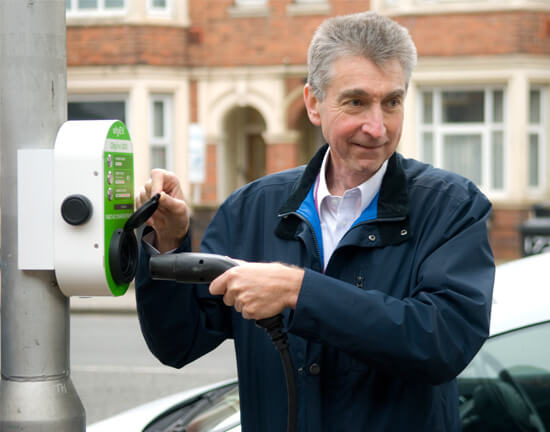




Lamp post charging points in Reading
Like many councils across the country, Reading Borough Council are looking at providing electric car charging infrastructure for their residents. The aim is to increase the uptake of electric vehicles across their region, and thereby reduce carbon dioxide emissions (climate change) and NOx and particulate pollution (local air quality and public health).
“Electric vehicle charging infrastructure is clearly required and it is up to local government to provide it.”, explained Councillor Tony Page. “We’re therefore looking at all options to increase uptake of EV within the Borough”.
Given that there are an estimated 52,000 people in Reading with no off-street parking, Reading Borough Council decided to develop a scheme that could serve this section of the community.
Lamp post charging points
The most elegant solution in this case is to use lamp post electric car chargers. These use small EV charge points attached to the lamp post itself and served from the existing electrical supply to that lamp post. It removes the need for additional street furniture, by using the existing infrastructure.
Joju were chosen to install a total of 15 charge points on lamp posts on Coventry Road, Filey Road, Manchester Road, St Bartholemews Road, East Street, Anstey Road Caversham Road and Wantage Road. The locations were chosen from responses to the council’s ‘Go Electric’ public consultation, whereby residents with an electric car, or planning to get an electric car, could request charge points in their locality.
City EV’s lamp post chargers
For this project, we chose City EV Cityline 100 Smart Charging units. These are ‘Elexon approved’, which means they are certified for being used powered by unmetered public street lighting. The charge points are currently free to use, but in future they will be accessed by RFID card or via a mobile phone app. City EV also make a contactless card payment version of the charge point, which offers another convenient payment method for councils.
The lamp post charging points are 3.6 kW units due to the size of the electricity supply to the lamppost, but these are perfectly sufficient for an overnight charge.
Procuring lamp post charging points
The scheme was procured through the Central Southern Regional Framework, providing Reading Borough Council with a rapid and simple procurement and project development process. The Framework is developing a coherent charging network for councils across the south of England.
Sites for lamp post electric car chargers
Although the Go Electric consultation produced a long list of potential sites, not all of these were technically simple. Many of the lamp posts in Reading are on the house side of the pavement, meaning that additional street side columns would be required, plus additional cabling running under the pavement from the lamp post.
Therefore, for this first phase it was decided to focus solely on simple lamp post charging points and so the sites chosen were those where the lamp posts were located on the kerb side of the pavement.
Technically the installation of the charge points was very simple – the electricity supply was already in place so it was just a question of mounting the charge point on the lamp post column and registering this with the back-office payment system. It’s also more cost effective – because the electricity supply is already in place, the expense of getting new connections can be saved.
The future of lamp post charging points
These lamp post charging points are just the start for Reading Borough Council. “We’re bringing forward our new Transport Plan, which will take a broader more holistic view of transport in the City”, said Councillor Page. “We recognise that switching from fossil fuel vehicles to EVs helps with pollution, but doesn’t address congestion in the city – a car is a car, electric or not! So it’s important to take a broader vision of transport, and look at more radical potential options like introducing low emission zones”. That said, further lamp post charging points, as well as units in public car parks and workplaces, are likely to be developed over the coming years.
Overall, lamp post charging points are an ideal technical solution for low cost, simple charging solutions for urban areas that lack off street parking. With 40% of homes nationwide having no off-street parking, lamp post electric car chargers look an essential piece of technology for making the electric vehicle transition available to all.
Find Out More ….
- We’re helping public authorities develop their electric vehicle charging infrastructure. You can see our case studies here
- We’re appointed to the Transport for London framework, specifically to install lamp post electric car chargers across London Boroughs
- See here for further information about lamp post charging points
Category
EV Charging, Public EV, Public Sector


